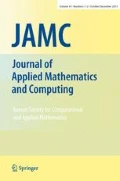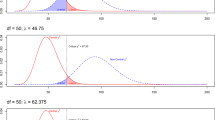Abstract
In the case of containing endogenous covariates, we study the variable selection problem for Poisson regression models based on the instrumental variable adjustment technology. By using a modified smooth-threshold estimating equation technology, we propose an instrumental variable based variable selection procedure. The proposed method can attenuate the effect of endogenous covariates, and is easy for application in practice. We also prove that this variable selection procedure is consistent in theory. Some simulations and a real data analysis are given to evaluate the performance of the proposed method, and simulation results show that the proposed variable selection procedure is workable.
Similar content being viewed by others
References
McCullagh, P., Nelder, J.A.: Generalized Linear Models, 2nd edn. Chapman and Hall, New York (1989)
Windmeijer, F., Santos Silva, J.M.C.: Endogeneity in count data models: an application to demand for health care. J. Appl. Econom. 12, 281–294 (1997)
Greenland, S.: An introduction to instrumental variables for epidemiologists. Int. J. Epidemiol. 29, 722–729 (2000)
Hernan, M.A., Robins, J.M.: Instruments for causal inference-an epidemiologists dream? Epidemiology 17, 360–372 (2006)
Newhouse, J.P., McClellan, M.: Econometrics in outcomes research: the use of instrumental variables. Annu. Rev. Public Health 19, 17–24 (1998)
Mullahy, J.: Instrumental-variable estimation of count data models: applications to models of cigarette smoking behavior. Rev. Econ. Stat. 79, 586–593 (1997)
Wooldridge, J.M.: Econometric Analysis of Cross Section and Panel Data, 2nd edn. MIT Press, Cambridge (2010)
Hall, A.R.: Generalized Method of Moments. Oxford University Press, Oxford (2005)
Roy, J., Alderson, D., Hogan, J.W., Tashima, K.T.: Conditional inference methods for incomplete Poisson data with endogenous time-varying covariates: emergency department use among HIV-infected women. J. Am. Stat. Assoc. 101, 424–434 (2006)
Fan, J., Liao, Y.: Endogeneity in ultrahigh dimension. Ann. Stat. 42, 872–917 (2014)
Liao, Z.: Adaptive GMM shrinkage estimation with consistent moment selection. Econom. Theory 29, 857–904 (2013)
Zhao, P.X., Li, G.R.: Modified SEE variable selection for varying coefficient instrumental variable models. Stat. Methodol. 12, 60–70 (2013)
Ueki, M.: A note on automatic variable selection using smooth-threshold estimating equations. Biometrika 96, 1005–1011 (2009)
Li, G.R., Lian, H., Feng, S.Y., Zhu, L.X.: Automatic variable selection for longitudinal generalized linear models. Comput. Stat. Data Anal. 61, 174–186 (2013)
Lai, P., Wang, Q.H., Lian, H.: Bias-corrected GEE estimation and smooth-threshold GEE variable selection for single-index models with clustered data. J. Multivar. Anal. 105, 422–432 (2012)
Ueki, M., Kawasaki, Y.: Automatic grouping using smooth-threshold estimating equations. Electron. J. Stat. 5, 309–328 (2011)
Cai, Z., Das, M., Xiong, H., Wu, X.: Functional coefficient instrumental variables models. J. Econom. 133, 207–241 (2006)
Acknowledgements
This research is supported by the Chongqing Research Program of Basic Theory and Advanced Technology (cstc2016jcyjA0151), the Social Science Planning Project of Chongqing (2015PY24), the Fifth Batch of Excellent Talent Support Program for Chongqing Colleges and University (2017-35-16), and the Scientific Research Foundation of Chongqing Technology and Business University (2015-56-06).
Author information
Authors and Affiliations
Corresponding author
Appendix
Appendix
Proof of Theorems
In this section, we present the technical proofs of Theorems 1–3. For convenience and simplicity, let C denote a positive constant which may be different values at each appearance throughout this paper.
Proof of Theorem 1
Let \(\beta =\beta _{0}+\tau \gamma \), where \(\tau =n^{-1/2}\). We first prove that, for any given \(\epsilon >0\), and a large n, there exists a constant C such that
This will imply that there exists a local solution to the equation \({\hat{S}}_{n}(\beta )=0\) such that \({\hat{\beta }}=\beta _{0}+O_{p}(n^{-1/2})\) with probability at least \(1-\epsilon \).
Denote \(\varLambda (\beta )=(\beta _{0}-\beta )^{T}{\hat{S}}_{n}(\beta )\), then a simple calculation yields
where \({\tilde{\beta }}\) lies between \(\beta \) and \(\beta _{0}\). Next we will consider \(J_{n1}\) and \(J_{n2}\), respectively. For \(J_{n1}\), by some elementary calculations, we have
Note that \(E\{\varepsilon _{i}|Z_{i}\}=0\), we can prove that
Then, invoking \(\Vert I_{p}-{\hat{\varDelta }}\Vert \le 1-\min \{{\hat{\delta }}_{k}\}\), a simple calculation yields
By using Taylor expansion, we can derive that
where \({\tilde{X}}_{i}^{T}\beta _{0}\) lies between \(X_{i}^{T}\beta _{0}\) and \({\hat{X}}_{i}^{T}\beta _{0}\). Then, invoking \({\hat{\varGamma }}=\varGamma +O_{p}(n^{-1/2})\) and \(E(e_{i}|Z_{i})=0\), and using the similar argument to the proof of \(J_{n1,1}\), we have that
In addition, since \({\hat{\delta }}_{k}=\min \{1,\lambda /|{\hat{\beta }}_{k}^{0}|^{2}\}\), we have
Then, invoking (11)–(13), we can obtain
Now consider \(J_{n2}\). A simple calculation yields
Hence, we have
By some calculations, we can prove that
In addition, it is easy to show that
Hence invoking (14)–(16), and by choosing a sufficiently large C, \(J_{n2,1}\) dominates \(J_{n2,2}\) and \(J_{n1}\) uniformly in \(\Vert \gamma \Vert =C\). Furthermore, \(J_{n2,1}\) is positive for the sufficiently large C. Then by (10), we have that for any given \(\epsilon >0\), if we choose C large enough, (9) holds. This implies, with probability at least \(1-\epsilon \), that there exists a local solution \({\hat{\beta }}\) such that
Together this with \(\tau =n^{-1/2}\), we complete the proof of Theorem 1. \(\square \)
Proof of Theorem 2
Let \({\mathcal {A}}_{0}^{c}=\{k|\beta _{k0}=0\}\), then for any given \(k\in {\mathcal {A}}_{0}^{c}\), by using the similar arguments as in the proof of Theorem 1, we have that the initial estimator \({\hat{\beta }}_{k}^{(0)}\) satisfies that \({\hat{\beta }}_{k}^{(0)}=O_{p}(n^{-1/2})\). Then note that \(n\lambda \rightarrow \infty \), we can derive that

This implies that
On the other hand, for any given \(\epsilon >0\) and \(k\in {\mathcal {A}}_{0}\), by the condition \(n^{1/2}\lambda \rightarrow 0\), we have that

This implies that \({\hat{\delta }}_{k}=o_{p}(n^{-1/2})\) for all \(k\in {\mathcal {A}}_{0}\). Hence we prove that
Then, invoking (17) and (18), we complete the proof of Theorem 2. \(\square \)
Proof of Theorem 3
From Theorem 2, we know that, with probability tending to 1, \({\hat{\beta }}_{k}=0\) for \(k\in {\mathcal {A}}_{0}^{c}\), and \({\hat{\beta }}_{\mathcal {A}_{0}}\) satisfies the smooth-threshold generalized estimating equations
Following Theorem 1, we have \({\hat{\beta }}_{\mathcal {A}_{0}}=\beta _{\mathcal {A}_{0}}+O_{p}(n^{-1/2})\). Then, applying the Taylor expansion to (19) at \(\beta _{\mathcal {A}_{0}}\), we can get
where \({\hat{G}}_{\mathcal {A}_{0}}=(I_{|\mathcal {A}_{0}|}-{\hat{\varDelta }}_{\mathcal {A}_{0}})^{-1} {\hat{\varDelta }}_{\mathcal {A}_{0}}.\) In addition, some calculations yield
Hence, we have
Furthermore, invoking \({\hat{\varGamma }}=\varGamma +O_{p}(n^{-1/2})\) and \({\hat{X}}_{i,{\mathcal {A}}_{0}}={\hat{\varGamma }}_{{\mathcal {A}}_{0}}Z_{i,{\mathcal {A}}_{0}}\), we can derive that
Next we show \(\frac{1}{\sqrt{n}}{\hat{U}}(\beta _{\mathcal {A}_{0}})\) is asymptotically normally distributed with mean zero and covariance matrix \(M(\beta _{\mathcal {A}_{0}})\). Applying a Taylor expansion to \(\exp ({\hat{X}}^{T}_{i,\mathcal {A}_{0}}\beta _{\mathcal {A}_{0}})\) at \(X^{T}_{i,\mathcal {A}_{0}}\beta _{\mathcal {A}_{0}}\), it is easy to show that
Hence we have
Note that \(E(\frac{1}{\sqrt{n}}\sum _{i=1}^{n}\eta _{i,\mathcal {A}_{0}})=0\), and \(Cov(\frac{1}{\sqrt{n}}\sum _{i=1}^{n}\eta _{i,\mathcal {A}_{0}})=M_{n}(\beta _{\mathcal {A}_{0}})\rightarrow M(\beta _{\mathcal {A}_{0}})\), then using the Central Limits Theorem, we have
Hence, invoking (23)–(25) and the Slutsky theorem, we complete the proof of Theorem 3. \(\square \)
Rights and permissions
About this article
Cite this article
Huang, J., Zhao, P. & Huang, X. Instrumental variable based SEE variable selection for Poisson regression models with endogenous covariates. J. Appl. Math. Comput. 59, 163–178 (2019). https://doi.org/10.1007/s12190-018-1173-0
Received:
Published:
Issue Date:
DOI: https://doi.org/10.1007/s12190-018-1173-0
Keywords
- Poisson regression model
- Smooth-threshold estimating equation
- Endogenous covariate
- Variable selection
- Instrumental variable




